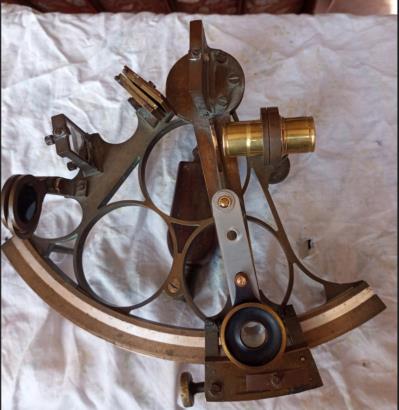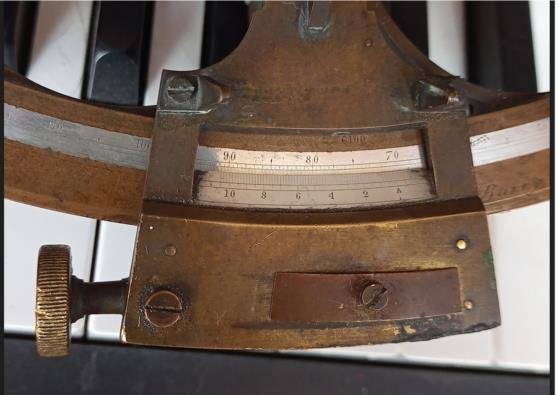
NavList:
A Community Devoted to the Preservation and Practice of Celestial Navigation and Other Methods of Traditional Wayfinding
From: Jürgen Hoefeld
Date: 2022 Jun 25, 19:35 +0200
A poster on the Gunroom forum had the following question.“I have recently bought a sextant dating most probably from the 1890s and bearing
the name of H. G. Blair & Co. of Cardiff, although I suspect that this company
was only a retailer. It was incomplete (lacking the telescope, the magnifier on
a swivelling arm over the vernier scale, and one of the smoked-glass shades),
but I have managed to supply the missing parts after a fashion. Unfortunately
this instrument can no longer give very precise readings, since the threaded
shaft of the vernier adjuster is slightly bent so that the vernier scale can
only move through about a fifth of its original travel before the shaft jams
solid. The sextants familiar to Jack Aubrey and his officers would have been
very similar, I believe, although the Ramsden instrument of 1772 shown in the
illustrated edition of 'Longitude' is much larger (15" radius, as against about
8" on mine) and has a less complicated frame.
It is the vernier that puzzles me. As I understand it, the principle of
this device is that the units on the separate vernier scale are made either
slightly larger or slightly smaller than the divisions on the main scale; thus
on my Celestaire cardboard sextant the vernier scale spans one degree in
5-minute increments, the whole degree being equal to 11 degrees on the main
scale. Readings are taken by noting the nearest whole degree on the main scale
to the zero mark on the vernier scale, and then establishing the number of
minutes by finding a point where the marks on the two scales exactly coincide.
(Please correct this as required if I am mistaken.) On the Blair instrument, by
contrast, the vernier is engraved 0 to 10 (are these minutes, or are they tenths
of a degree?), each unit being subdivided into six, and the 0–10 range spans
exactly twenty degrees on the main scale; thus each half-unit on the vernier is
precisely equal to one degree on the main scale and there is no staggering or
offsetting between the two scales, so that the 'interpolation' method of reading
which I have tried to describe above cannot apply. Can anyone tell me how this
instrument would have been read?I have been calling the Blair instrument a sextant, but I believe it
should strictly be designated a quintant, since the main scale extends over 150°
rather than the more usual 130°. The engraving on the scales (still done by hand,
I believe) is extraordinarily delicate, each degree on the main scale being ruled
off in six ten-minute divisions which my tired old eyes can barely resolve
unaided.”Can someone help him out and explain how this vernier works?Don Seltzer








